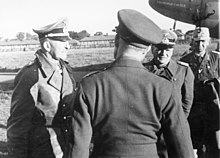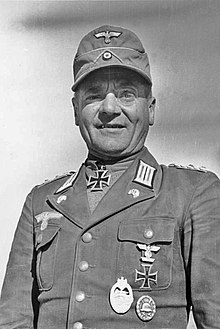Hans Cramer
Hans Cramer (born July 13, 1896 in Minden ; † October 28, 1968 there ) was a German officer , most recently a general of the armored forces in World War II .
Life
origin
The longest-serving officer in the Minden regiment and the author of various books for the regiment, Alfred Cramer was his father.
Military background
Cramer belonged to the Prussian Cadet Corps and entered on August 10, 1914, shortly after the outbreak of World War I , as an ensign in the infantry regiment "Prince Friedrich of the Netherlands" (2nd Westphalian) No. 15 in his hometown. With this he came from October 24, 1914, after his father was already a French prisoner of war , on the Western Front and was promoted to lieutenant on December 25, 1914 . From August 22nd, Cramer was a company commander and from March 4th, 1916, a battalion adjutant in his regiment. As leader of the 1st MG Company, he was transferred to the Infantry Regiment "Graf Bülow von Dennewitz" (6th Westphalian) No. 55 on July 5, 1918 . Cramer was taken prisoner by the British on August 8, 1918 , from which he was released on April 15, 1919.
After his release, he was taken over by the Reichswehr and Cramer was initially assigned to the 14th Infantry Regiment, where he was deployed as deputy regimental adjutant from August 10, 1920. Shortly thereafter, on October 1, 1920, he was transferred to the 18th Infantry Regiment , from there on January 1, 1923, he transferred to the 13th (Prussian) Cavalry Regiment . After being transferred to the training squadron in spring 1924, he was promoted to first lieutenant on April 1, 1925 . After serving in various other units, he was promoted to Rittmeister on February 1, 1931 . On January 1, 1936, he was promoted to major and on February 1, 1939 to lieutenant colonel.
After the mobilization he became commander of the cavalry training and testing department on August 26, 1939. This unit was reclassified to the education department. With this unit Cramer took part in the attack on Poland , where he received both braces for the Iron Cross, and in the French campaign. He was promoted to colonel on October 1, 1941 and transferred to the 10th Panzer Division to train as a commander of a tank regiment . On March 25, 1941 he was appointed commander of the 8th Panzer Regiment of the 15th Panzer Division . In April 1941, his unit was transferred to Africa as part of the German Africa Corps . Seriously wounded on June 24th, he was awarded the Knight's Cross of the Iron Cross three days later for his service in the Sollum Battle. In mid-September 1941 he was able to take command of the 8th Panzer Regiment again and on October 1, 1941 he was promoted to colonel. On April 1, 1942, Cramer was appointed Chief of Staff of the General of the Rapid Troops at the OKH and on November 1, while being promoted to Major General , to General of the Rapid Troops. In November 1942 he was briefly with the deputy leadership of the XXXXVIII. Panzer Corps entrusted. On January 22, 1943 he was promoted to lieutenant general and took over the command of the general command z. BV Cramer commissioned. On February 10, 1943, after being replaced by Erhard Raus , he was transferred to the Führerreserve . He returned to Africa on March 13, 1943 as the commander and commanding general of the German Africa Corps, and on May 1, 1943, he became General of the Panzer Force. On May 12, 1943, when the Corps surrendered, he was taken prisoner by the British.

From May 16, 1943 to February 22, 1944 Cramer was interned in the English general camp Trent Park . Allegedly because of his severe asthma , he was released by the British to Germany in May 1944, but previously informed of an imminent landing by the Allies on the coast of Calais so that upon his return he would report the same to the German military leadership of the actual landing in to distract Normandy. Cramer was even received for dinner by the American General George S. Patton for this Allied deception ( Operation Fortitude ) . This was supposed to lead the American troops that were supposed to land on the European mainland. After his return, Cramer reported personally to Hitler, who was confirmed in his belief that the Allies would land in the Calais area. As a general z. BV Cramer was then transferred to Panzer Group West in France. He was not given a new command there, but was in contact with Erwin Rommel . As a former prisoner of war, he was suspected of complicity after the assassination attempt on July 20, 1944, and was interrogated from July 26 to August 5, 1944 in the Gestapo prison on Prinz-Albrecht-Strasse in Berlin. He then came to a subcamp of the Ravensbrück concentration camp and was released from the Wehrmacht on September 14, 1944. At the end of September he was admitted to the Berlin Charité . He had been under house arrest since December 24, 1944. He was used by the British from May 1945 to February 15, 1946 as commander-in-chief of all captured German troops in Holstein ( Wehrmacht Staff North ).
Awards
- Iron Cross (1914) 2nd and 1st class
- Lippe War Cross of Honor for heroic deed
- Lippe War Merit Cross
- Lippe cross for faithful service
- Wound badge (1918) in silver
- Wehrmacht service award IV. To I. class
- Clasp for the Iron Cross, 2nd and 1st class
- Tank battle badge in silver
- Knight's Cross of the Iron Cross on June 27, 1941
- German cross in gold on March 5, 1942
- Arm band Africa
- Commander's Cross of the Colonial Order of the Star of Italy on May 7, 1942
literature
- Sönke Neitzel : bugged. German generals in British captivity 1942–1945 . Propylaen, Berlin 2005, ISBN 3-54907261-9 (edition of intercepted conversations in the prisoner of war camp [selection])
- Martina Metzger: Hans Cramer: Biography , Bayreuth: Verlag Veit Scherzer 2018, ISBN 978-3-938845-71-4 .
- Dermot Bradley : The Generals of the Army 1921-1945 Volume 2 v. Blanckensee-v. Czettritz and Neuhauß , Biblio Verlag, Osnabrück 1993, ISBN 3-7648-2424-7 , pp. 466-467.
Individual evidence
- ↑ Birth certificate, registry office Minden 357/1896
- ↑ death certificate registry office Minden 991/1968
- ↑ James Leasor: CODE NAME NIMROD . Playboy Paperbacks, New York 1982, ISBN 0-867-21030-3 , p. 142
- ↑ a b c d e Ranking list of the German Reichsheeres , Mittler & Sohn Verlag, Berlin 1930, p. 155
- ↑ a b Veit Scherzer : Knight's Cross bearer 1939–1945. The holders of the Iron Cross of the Army, Air Force, Navy, Waffen-SS, Volkssturm and armed forces allied with Germany according to the documents of the Federal Archives. 2nd Edition. Scherzers Militaer-Verlag, Ranis / Jena 2007, ISBN 978-3-938845-17-2 , p. 262.
| personal data | |
|---|---|
| SURNAME | Cramer, Hans |
| BRIEF DESCRIPTION | German officer, most recently General of the Panzer Force |
| DATE OF BIRTH | July 13, 1896 |
| PLACE OF BIRTH | Minden |
| DATE OF DEATH | October 28, 1968 |
| Place of death | Minden |
